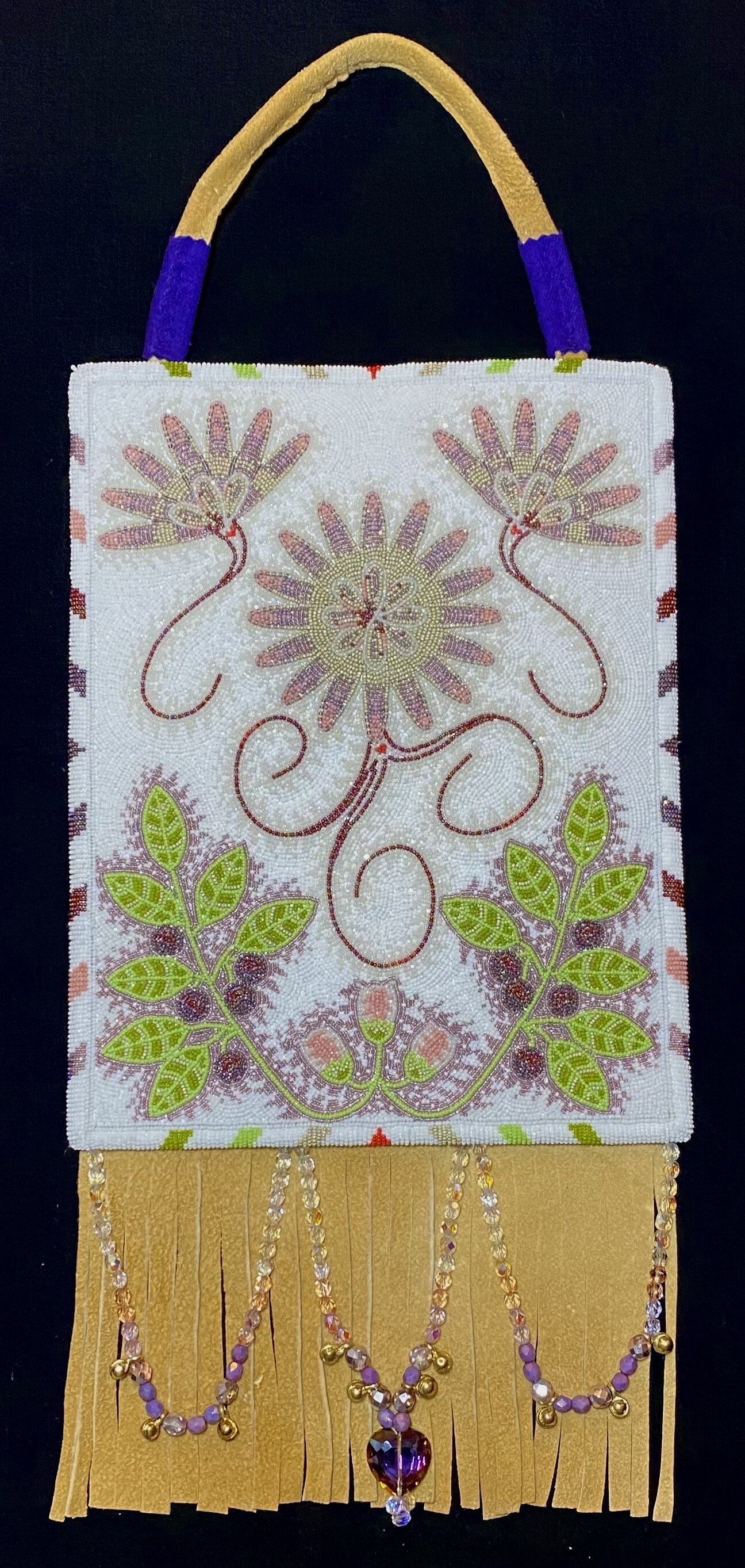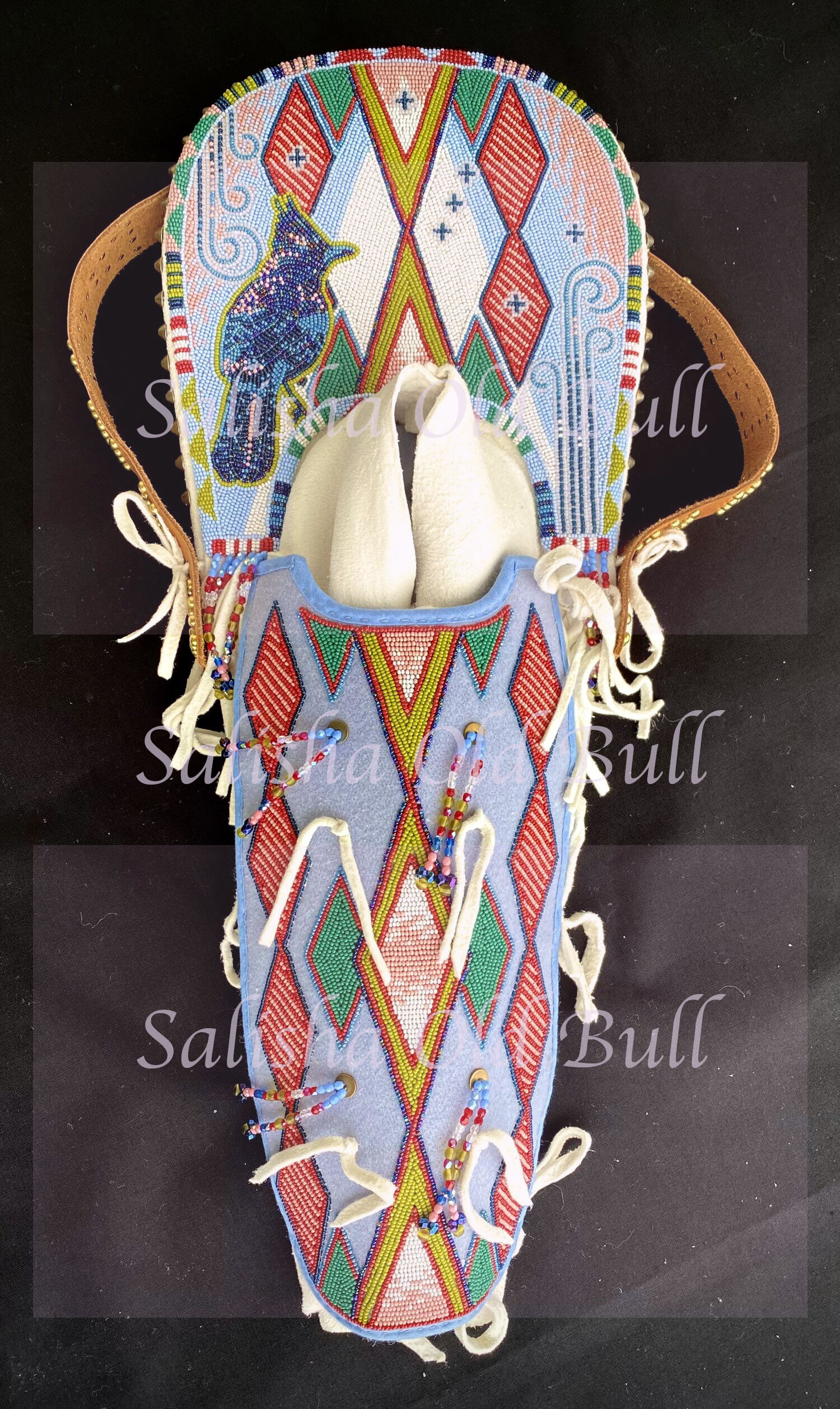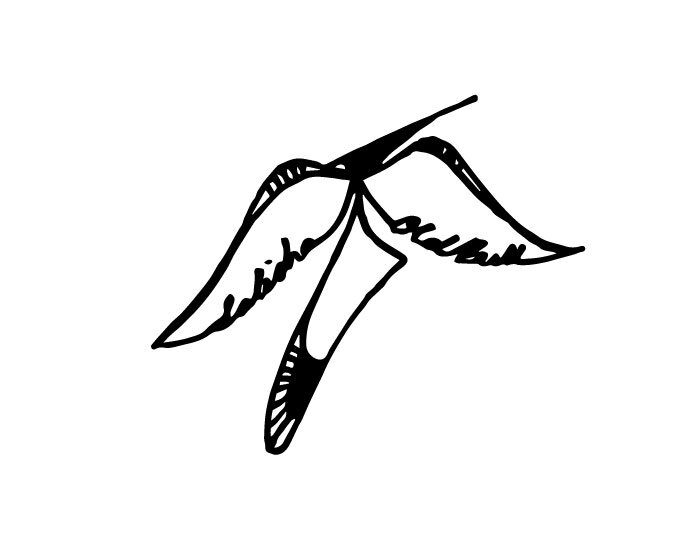Beadwork
My work is done with glass seed beads, size depending on type of projects. I was raised by Salish women and my work is influenced by Bitterroot Salish designs and traditional concepts. I occasionally incorporate Absáalooke (Crow) inspired colors and concepts, which represent both my tribal backgrounds and identities. Most work is done as flat-stitched, two-needle work.

Bitterroot & Huckleberries (2021). 8.5" x 11" beadwork surface, not including fringe length. Combination of modern and vintage size 13 true-cut seed beads, stabilizer, deer hide, wool, cotton fabric, nylon thread, czech beads, brass bells, one plastic button. Technique is flat-stitch, two-needle, contour beadwork. Exhibition: Knowledge from Land (2021), University Center Gallery, Missoula MT Award: 100th Annual Santa Fe Indian Market: 2nd place award in Classification VII: Diverse Art Forms, Div. A: Functional objects, Category 2707. This purse is apart of a private collection.

Qwasqwi, Storm, Five Friends & the Canoe (2021). 7.7" x 1' 7". Red vintage true-cut, size 13 seed beads, true-cut, size 13 seed beads, deer hide, wood, cotton fabric, wool, leather, stabilizer, czech beads, nylon and cotton thread, brass tacks and spots. The first cradleboard in a series of four cradleboards, representing the four seasons. This board represents the winter season. Award: 63rd Annual Heard Museum Guild Indian Fair & Market: 1st place award in Division D-Functional objects such as bows and arrows, cradleboards, bows, weapons, shields, furniture, lamps, musical instruments, bull roarers, beaded bottles, and other objects. Exhibition: "Expressions of Resilience" at Bigfork Arts & Cultural Center showing May 8-June 26, 2021. Exhibition: "Finding Our Place: Beading and Weaving Our Culture Together" at City Scape Community Art Space, in North Vancouver BC, Oct. 8-Nov. 13, 2021. Awards 2022: Harrison Eiteljorg Purchase Award, Best of Division in Traditional Beadwork (Eiteljorg Museum), First Place in Traditional Beadwork (Eiteljorg Museum). This cradleboard is in the permanent collection of the Eiteljorg Museum.

Susan At Thunderhead (2021). 12" x 16" original photograph and beadwork on canvas. Donated to Open Air for fundraiser.

Salish Bitterroot Story (2022), 7.7" x 1' 7". Combination of vintage and contemporary size 13 seed beads, true-cut, deer hide, wood, cotton fabric, wool, leather, stabilizer, Czech beads, nylon and cotton thread, brass tacks and spots. The second cradleboard in a series of four cradleboards, representing the four seasons. This board represents the spring season. Shown at the 64th Annual Heard Museum Guild Indian Fair & Market Award 2022: Second Place in Traditional Beadwork (Eiteljorg Museum). This work is now owned by a private collector.

Salish Bitterroot Back Bag (2022). 6in. x 6 in., Size 13 true cut Czech beads (combination of modern and vintage). Brain-tanned, smoked, deer hide, nylon thread, stabilizer, and paper. This bag is in the permanent collection of the Montana Museum of Arts and Culture.

Remember That Night At Buffalo Camp (2022). 7.7" x 1' 7". Red and Green vintage true-cut, size 13 seed beads, true-cut, size 13 seed beads, deer hide, wood, cotton fabric, wool, leather, stabilizer, czech beads, nylon and cotton thread, brass tacks and spots. The third cradleboard in a series of four cradleboards, representing the four seasons. This board represents the summer season. Award: 100th Annual Santa Fe Indian Market: 2nd place award in Classification VIII: Beadwork & Quillwork, Div. C: Other items, Category 3102. This cradleboard is apart of a private collection.

Signs of Autumn (2023). 7.7" x 1' 7". Vintage and modern true-cut, size 13 seed beads, deer hide, wood, cotton fabric, wool, leather, stabilizer, glass beads, nylon and cotton thread, brass tacks and spots. The fourth cradleboard in a series of four cradleboards, representing the four seasons. This board represents the autumn season. Award: 65th Annual Heard Museum Guild Indian Fair & Market: Honorable Mention award in Division D-Functional objects such as bows and arrows, cradleboards, bows, weapons, shields, furniture, lamps, musical instruments, bull roarers, beaded bottles, and other objects. This work is now owned by a private collector.

The Roses We Know (2023). 13" x 6-3/16" x .25". Technique is flat-stitch, two-needle, beadwork. Materials are true cut, size 13 Czech modern and vintage seed beads, brain-tanned smoked deer hide, glass and crystal beads, nylon cord, stabilizer, thread, and cotton material. This purse shows the images of wild roses that grow in Western Montana. The plant is significant to the Bitterroot Salish people as the blooming represents the buffalo are fat and ready to hunt. This purse now belongs to a private collector.

Meadowlark Will Tell You (2023). This bag depicts the meadowlark, which is significant in both the Apsaalooke and Salish Cultures. For the Salish this bird had a tendency to tell others, they wouldn't keep secrets and had a habit of telling things they'e seen. They were sort of getting themselves in binds because of telling on what they had seen. They used to sing in Salish but we can't understand them anymore. For Apsaalooke culture, the bird was known to be a blessing if it was around your dwelling. This bird is in many stories and teaches us the importance of minding our own business. The background is reminiscent of a Salish style short fringe dress. The flower is shooting star which appears in the spring in Western Montana.

Matriarch (2023). 7.7" x 1' 7". Cradleboard. Vintage and modern true-cut, size 13 seed beads, deer hide, wood, cotton fabric, wool, leather, stabilizer, glass beads, nylon and cotton thread, brass tacks and spots. The bison are a matriarchal society and the female serves as the leader over the herd. This board portrays the matriarch of the herd. Bison are matrilineal and I wanted to show this. I beaded the lone head of the herd, a female bison. The males and females have separate herds and the males have a heard of bachelors. The herds only convene when it's mating season. There also a few landscape images to show the time of year that we use to go hunt for summer bison. There's a lot of wild roses that depicts the bison are fat and ready to hunt. There's also some sweet sage and a camas flower with the bulb. We used to eat camas and gather it just before the roses bloom. In the permanent collection of the Smithsonian National Museum of the American Indian.

Wewi (2024). Czech beads, nylon thread, brain-tanned smoked deer hide, paper. It mimics a piece of dance regalia and is meant to adorn. Montana came to our aboriginal territory only recently, compared to the time the Bitterroot Salish and Absaaloke nations have inhabited this area. I chose to bead a meadowlark, which is special in both cultural histories and indicates pieces of knowledge. For the Bitterroot Salish, the meadowlark, or Wewi, is known to tell the news. The stories about Wewi can be heard in the winter time. For the Absaaloke, the meadowlark, or baauuwatshiile, is considered a blessing if it resides by your dwelling. The bird is also the state bird for Montana. It felt appropriate to create Wewi/baauuwatshiile as part of the Art Mobile Fiber Art Exhibition for elementary children to help educate and include all children the full history of this land.
Feel free to contact me at my email account to discuss work with sale prices.

